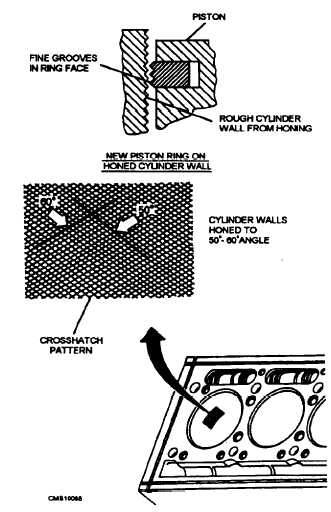When piston rings are new, a period of running is necessary to wear the piston rings a small amount, so they conform perfectly to the cylinder walls. The cylinder walls are surfaced with a tool called a hone, which leaves fine scratches in the cylinder walls (fig. 3-37). The piston rings are made with grooves in their faces, which rub against the roughened cylinder walls, serving to accelerate ring wear during the initial stages. As the surfaces wear smooth, the rings wear in.
Extreme pressure may be applied to high spots on the piston rings during the wear-in period. This can cause the piston rings to overheat at these points and cause damage to the cylinder walls in the form of rough streaks. This condition is called scuffing. New piston rings are coated with a porous material, such as graphite, phosphate, or molybdenum. These materials absorb oil and serve to minimize scuffing. As the rings wear in, the coatings wear off.
Some piston rings are chrome-plated. Chrome- plated rings provide better overall wearing qualities. They also are finished to a greater degree of accuracy, which lets the piston rings wear in faster.

Figure 3-37. - Piston ring wear-in.
Connecting Rods
Connecting rods connect the pistons to the crankshaft. They must be strong enough to transmit the thrust of the pistons to the crankshaft and to withstand the internal forces of the directional changes of the pistons. The connecting rods (fig. 3-38) are in the form of an I-beam. This design gives the highest overall strength and lowest weight. They are made of forged

Figure 3-38. - Connecting rod construction.
Continue Reading